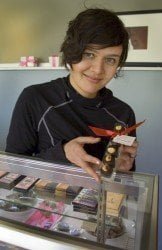
All photos © Vince Patton Photo
“This is for you,” says Elizabeth Montes, sliding across the café table a small packet containing five Sahagún chocolates, curlicue palets sifted with silver and buttery salty caramels crowned with hazelnuts, chocolates exuding both probity and whimsy and so individually stunning they have the quality of jewelry.
Over an Americano, Montes (who, with her enormous dark eyes and bobbed hair resembles Amelie actress Audrey Tautou) spoke of chocolate’s allure with equal parts wonder and conviction; a little magical realism, if you will, which makes consummate sense once one realizes the 35-year-old is possessed of the artist’s temperament: dreamy, serious about her work while bound by curiosity to constantly change it, and keen for customers entering her glittering sliver of a shop in Northwest Portland, to give themselves over, no questions asked.
When and why did you start making chocolate?
I think in 1995. I’d just arrived in New York [from a year in Mexico] and I asked my boyfriend to ask anyone he knew where the shops were. It was around Valentine’s Day, and something in the [New York Times] Dining section had just come out that had all the chocolate shops to go to, and that’s how I guess I started eating good boxes of chocolates.
Did you approach these shops for a job?
Oh, I didn’t want to work in it; I just wanted to eat it! Then, later that year, I bought a book and started making them, but just for fun. I never thought of doing it, that early; I was just playing around. My jobs were always art-based things; ceramic shops, decorative painting and that kind of work; I didn’t start to put [together] “chocolate-making” and “making money off of chocolate” until I met the next boyfriend—the cook. And I thought, oh, yeah, selling what you make—okay! I make chocolates!
Did you have any professional training, or did you teach yourself?
I mainly taught myself. I mean, I read a lot of books… but I think I intentionally did not want to study chocolate making too formally mainly because I had done that with other things that I really loved, and then, it just became I was going to always be a student, and I didn’t want to have to let my mentality fall into that. I’m sure it’s great for people who study under other people; I think that’s excellent, but, I just kind of knew what I wanted to do and I didn’t want to be little anymore, like a student.
When I decided I was going to go into this line of work, I thought, okay, I’ll go work in a chocolate kitchen. It came about in a very logical way; I was working for a doll-maker, and in decorative painting, and I really wanted to find… the job of my life? (Laughs.) Or, my life’s work, and I was also graduating college—I went back and got my degree in Latin American literature, and I had just started working selling chocolates and learning how to deal with them, and I saw a man’s work, a chocolatier; he was also a painter, and he had a very painterly, artistic chocolate pieces, and I thought, well, I have that skill, I’ll go work for him and learn how to transfer my skill [to chocolate], and that’s how I got into the kitchen, and then I went to seminars and just practiced on my own, over and over, and then just started selling.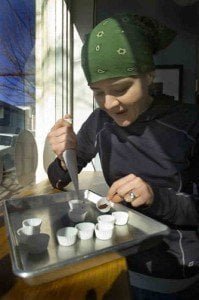
It’s interesting when you say you worked at a doll-maker’s and all these hands-on arts jobs, because Sahagún chocolates very much resemble tiny pieces of art. Not the shape and the color necessarily, but the impression.
Great! That makes me glad when people say that, because it’s kind of the unconscious idea behind the whole thing. Even the name of the company, Sahagún; it’s a name of an historical person who was from Sahagún, in Spain; he was a friar around Mexico City; there are several volumes called The General History of the Things of New Spain and now it’s called The Florentine Codex
, but anyway, he gets information from the natives there about culture and foodstuffs and they talk about chocolate; what it means to them; what a valuable thing it is, how special it is, and how it’s used as a form of money, and how there are even counterfeiters that can pass off [chocolates] that are more valuable than they really are, and how special of a thing it was—not like today, when we see a candy bar fall on the ground and it wouldn’t mean anything. Cocoa beans and the whole idea behind chocolate is something very special; it meant a lot; it was a costly thing. That is what I’m also trying to bring back and hope that my chocolates embody and how I approach it. To me, this means a lot. (Pause.) Sometimes it means a little too much. I don’t want to come off wacky but, I just get a little too into them sometimes, I think, but you know what? I don’t worry about them becoming too precious… For me, it’s a huge pleasure to be able to care for something that much, and that’s the way I feel about the chocolate.
When did you get to Portland?
In 2001. I just sold [chocolates] at the farmer’s market… and then I just put the word out to my boyfriend that I should probably get a shop at some point.
And you opened Sahagún…
Last year. 2005.

Do you use specific chocolate for one, and a specific chocolate for another? Are you using single origin chocolates?
Yeah, I do. I learned a lot at FCI [French Culinary Institute, in New York]; one [seminar] was put on by Michael Cluizel, and they were at that point trying to promote their Hacienda chocolate, which comes from one farm, and I really got into that… I work with chocolate, it’s in my kitchen, but I also sell different types of chocolate, and I want the freedom to change around the chocolate…. There are so many great chocolates coming out now that are available in couverture and also in bars, and I feel very curious about using different chocolates.
I don’t have much space so, I can’t deal with lots of different types at once—although that would be ideal; that would be really great—but instead, I’ve just been choosing and changing different couvertures; they’re always single-origins, but I like to explore different countries’ flavors, and I’ll use that for a while and people get used to the flavor and say, ‘I really like this style’ and, great, but… people don’t really know what they like the best until they try all types, and I kind of feel like I need to use different types just to bring to consciousness.
That’s the thing I like about single origins; I know that blends are just as valid, and I think blending is great, but right now, it’s so new and people are just now finding out that you can really appreciate chocolate. Most of the chocolates I have are chocolate bars and are single origins, and I just think people need to find out about these first and then maybe get into blends later.
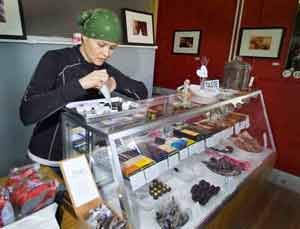
How many pounds of chocolate are you making a week?
It’s always different. People buy things at different rates, and I’m finding out that it’s super seasonally based. When I sold at the farmer’s market, it was every week; steady; sometimes it would be more for like, Mother’s Day, but in the shop, I’m really surprised that, some people just want… the way they think of chocolate, it’s for that day, and that’s great; now I understand what I’ve heard from other chocolate making friends, about how they count on those holidays for their income. Now, I’m starting to see that… I hate to gripe about this but, it just feels like it’s so hard to convince people to buy chocolates, people are used to paying fifty cents for something.
I never set out to make malted bunnies and things like that: I was not into that. If I can’t get people to buy chocolate during the rest of the year, and then they finally come in wanting chocolate bunnies, well, I can make chocolate bunnies with really good chocolate and that will make me feel, you know, I’m fine with that, as long as it’s going to be good chocolate.
Is there anyone else in town making interesting chocolate?
I think people are doing really good work. [Pix] has a big selection. I really like Alma’s sculptural stuff; she casts chocolate into molds that she makes; I think that’s great. I like David Beer’s stuff for Wingnut Confections.
Are there any chocolate books that you like?
It’s hard to say, because the most important thing that I learned was, it’s never how it is in the book. I thought a really great general book was not even technical, is Chocolate: A Bittersweet Saga of Dark and Light. That was an excellent book, but it’s more a history of chocolate.
Do you have one request you’d make of your customers?
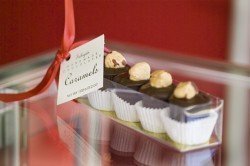 Oh, yes. (Laughs.) I feel like such an oddball about this because it just seems like asking so much, and it’s kind of contrary to what a good salesperson would do; they would tell you all about flavors before you even make your purchase. I just feel like, what I really want is for people to just trust their own tastes, in the beginning. A lot of people want you to tell them exactly what it’s going to be; they want you to almost have the experience for them. They know all the intellectual parts about it, and they want to be sure of that stuff before they get it, and it’s a taste, and I just feel like it’s almost a crime, I feel like I would be robbing, in a way.
Oh, yes. (Laughs.) I feel like such an oddball about this because it just seems like asking so much, and it’s kind of contrary to what a good salesperson would do; they would tell you all about flavors before you even make your purchase. I just feel like, what I really want is for people to just trust their own tastes, in the beginning. A lot of people want you to tell them exactly what it’s going to be; they want you to almost have the experience for them. They know all the intellectual parts about it, and they want to be sure of that stuff before they get it, and it’s a taste, and I just feel like it’s almost a crime, I feel like I would be robbing, in a way.
It can be compared with someone who says he wants to jump into the water, but first he wants to know how deep it is, how cold it is, what “wet” feels like and how he’s going to get dry again.
Yeah. I would have to say, yeah, that. And this is another thing that bothers me. I have a bunch of different chocolates, and they’re all pretty different; they’re all dark chocolates but there are little shades of difference and stuff like that. But, it’s chocolate. I just can’t put myself in somebody’s shoes who’s too desirous of information before they make the leap to buy a bar of chocolate. I know it’s more expensive than other chocolate, but it’s chocolate; you’re not going to be that disappointed if, say, you don’t catch the blackberries on the back of your tongue, you know? I don’t want to come off snooty but I just kind of feel I’m sort of let down by people giving up their control to what they’re going to experience.
For me, I personally hate reading descriptions of a coffee, wine; it just bothers me. And giving them [all this information] on my chocolate bars—because they’re in my humidity controlled case; people can’t pick them and read them; I write on the front what it says on the back—I just can’t bring myself to put what I think it is. We’re all in so many different states of readiness of taste buds; of how old our senses are; I just do not want to splash it on the [customer’s] experience. I think that a lot of people want that done for them, and I understand why; it gives them confidence in what they’re purchasing and I… I can’t do it.
Are you running your dream shop now?
I like that type of thing. If there are four people in there, the last person is going to get bumped by the door. But for me, it’s very sweet. It’s very personal; it’s a small space and you really have to engage with somebody. The regulars, it’s special to be able to know people’s names, and know what they like, and know if they’ve tried something, or you name something new and give samples; it’s like a little old town store.
Who’s your dream customer?
Hmmm. (Long pause.) I really like when people trust me; I have several of those. They’re really relaxed, they just really relax into the chocolate and they get inside the room they just kind of let go. Not that they pull out their money and spend; they can buy one piece, I don’t care, but their attitude is, they come in and experience the joy of the smell of it or the look of it or the appreciation of it in whatever sense.
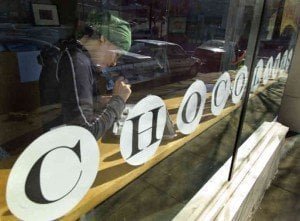 Do you have any advice for someone thinking of going into the chocolate business?
Do you have any advice for someone thinking of going into the chocolate business?
Yeah. Find a chocolate kitchen that faces north, that’s really important—unless they have heavy-duty air conditioning. My north-facing kitchen was in my apartment, and the breeze just naturally [came through]. Now I face west; I face the sunset. I really want to get an air conditioner that works.
Have you had your chocolates melt down because of this?
Well, people think chocolate needs to be really cold, fifty or sixty degrees; it can be seventy-five, but I’ve now found out how hot it can be. I’m not proud to say this but, it did get so warm last year that I did have to take the chocolates out [of the case] and put them in my wine cooler; I left the tags out there so when people came out it was just… the chocolates were invisible. It was kind of funny. (Smiles.) I actually sort of liked it.
All photography by Vince Patton – © 2006
Note: The retail store has closed
ladida says
Yes, it’s true. the chocolate is perfect. Try the mocha.. with stumptown. man. it’s good. I dream each day that I will have enough time to go and get one. And a salty caramel.
vicki says
I’ve been there a few times and I seem to be stuck on one kind — it was soo good I want it again and again. It’s the dark chocolate with pepitas and a little chili bite. Love the chocolate, love the crunch, love the heat — yumyum! I want some now! One of these days I’ll try one of those caramels…
Food Dude says
Viki – try the caramels. Trust me.
nancy says
As Elizabeth says, chocolate is yours to experience, so all I can offer is my own take on the caramels: one of the five best foods I have ever put in my mouth. Personal preference (and this, on a tip from Food Dude): put the whole thing in your mouth and bite.
Melissa McCall says
It was cold and windy yesterday morning, and all I could think about was Sahagun hot chocolate and brioche from Ken’s. I parked by the Jaguar dealership, walked to the door, and…. “oh God, it’s Tuesday.” I forgot that Sahagun is only open Wed-Sat. It reminded me of that old “Got Milk” commercial in which hell is full of cookies, but there’s no milk.
The only thing that would make Sahagun better is if it were open all the time. I hereby volunteer to watch over the salted caramels whenever Elizabeth needs a break.